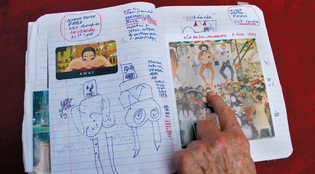 loading
loading
Professor of mambo Cathy ShufroThompson's notebooks contain comments, musical notation, sketches, and phrases and their translations, along with ticket stubs, symposium programs, and photographs of interviewees. Here he shows a notebook with his sketches of puppets, and a postcard, from the Frida Kahlo Museum in Mexico city. View full imageThompson’s best-known book—art historian Doris calls it “canonical” in the field—is found in academic bookstores and in any botánica worth its herbs and amulets. Flash of the Spirit: African and Afro-American Art and Philosophy explores how western and central African artistic, social, and spiritual traditions remain salient among black people throughout the New World. Along with Flash, Thompson’s works include nine other books and six major museum exhibitions he curated. Thompson has his detractors. He and other scholars were criticized by anthropologists Sidney Mintz and Richard Price in an influential 1976 book for what they saw as a failure to account for the transformation of African traditions in the New World. (By 1992, Mintz and Price felt that Thompson had adopted “greater conceptual flexibility.”) In a 2001 article, William and Mary anthropologist Sally Price asserts that Thompson’s sourcing methods make his evidence for links between African and New World textiles difficult to analyze. “Numerous pivotal assertions cannot be traced by readers,” she says, because the sources include unpublished works in progress, the content of phone conversations, and “personal communications.” Price takes care to note, however, that she is merely “sprinkling a few grains of salt on Thompson’s monumental contribution.” UCLA professor Donald Cosentino, whose field is culture and performance, says such criticisms derive in part from a larger divergence between two approaches to Black Atlantic scholarship: roots and routes. “The roots school would say that the most important thing to focus on is African origins. For the routes people, the most important thing is to study what happened to those inheritances in the New World. I think it’s a false dichotomy, in that I don’t think you could study the Black Atlantic without studying both roots and routes. And without Bob and his work, I think we would still have this view of Africa as peripheral. He ceased the ‘otherization’ of Africa, put it on the same level as Europe or Latin America or Asia. He changed Africa from being an object to a subject.” To some, it is surprising that Thompson did this work at Yale. In Tate’s view, Yale fosters “a Eurocentric vision of what art is, what culture is, what philosophy is: there are no Africans, no African Americans, whose vision and whose contributions are equivalent to those of the Greco-Roman tradition. Thompson begs to differ.” Thompson says that for every lecture he delivers, “there are thousands of television shows and other mass media that are giving the old vision of Africa: as remote tribal villages, when in fact the people of ancient Djenné were living in a city-state [that was] emerging at the same time the Greek city-states were emerging”—civilizations, like the Yoruba, with “standing armies, cowry-shell currency, cities.” When Europeans first visited the continent, he adds, they called the African cultures “nations”—but the nations “got demoted to ‘tribes’ in the late nineteenth century. So we have our work cut out for us.”
|
|